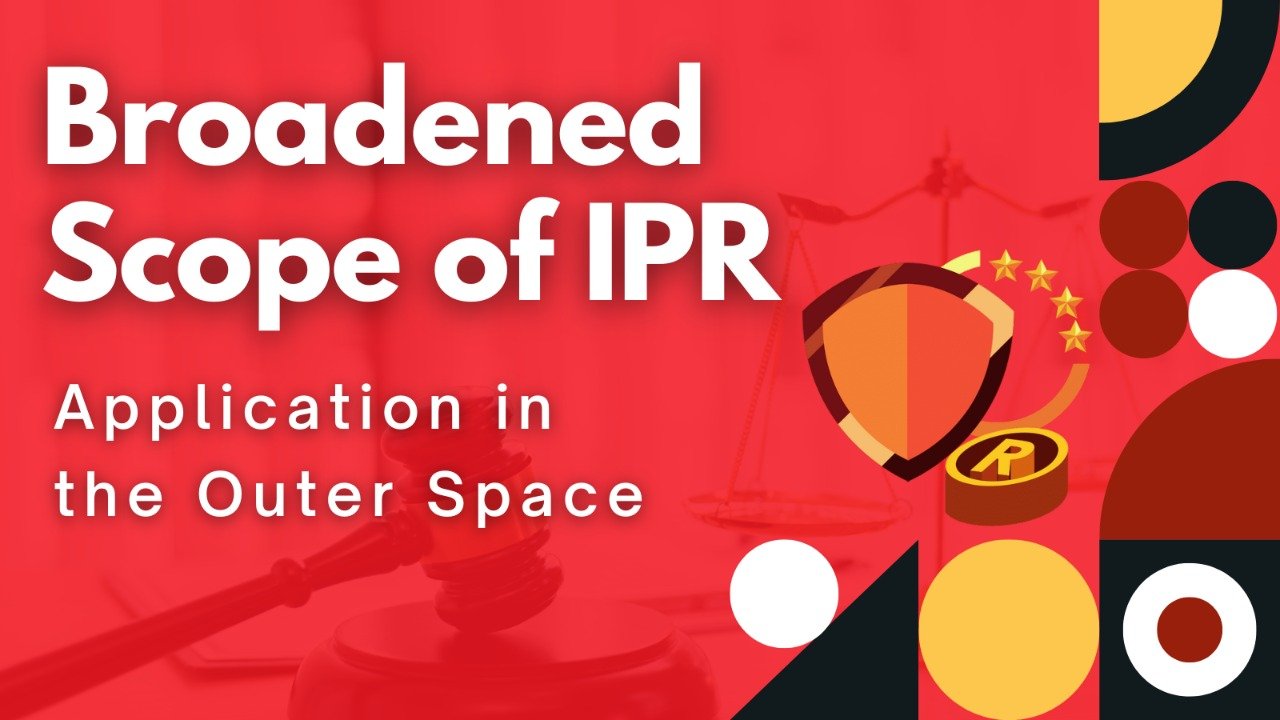BROADENED SCOPE OF IPR ~ APPLICATION IN THE OUTER SPACE

INTRODUCTION
In this era of business and technology, with greater commercialization of space exploration and space-related technologies, space law must be extended to meet specific issues that hinder development. A common worry is the necessity for a comprehensive Intellectual Property Rights (IPR) system that suits the demands of space-related producers and inventors. It is of the utmost significance that a legal framework be put in place to safeguard intellectual property in outer space. Space exploration and international collaboration will both suffer from a lack of legal clarity. With so much money at stake, the private sector needs legal protections to feel confident about entering the space industry. When it comes to competition, the limited exclusive rights granted by intellectual property protection would benefit right holders via the conclusion of a licensing agreement or the exclusion of rivals from exploiting a certain technology. It's possible that the creation of intellectual property rights may boost the company's reputation as a whole.
INTELLECTUAL PROPERTY IN SPACE ACTIVITIES
Space technology is one of the most sophisticated technological areas, and outer space operations are the fruit of creative inventions. However, intellectual property protection in relation to outer space activities has only gained attention in recent years. Space operations are changing from state-owned to private and commercial. These include space remote sensing, direct broadcasting, and microgravity research and production. Commercial sector engagement is growing, and so is privatisation, as with Inmarsat and Intelsat. Non-governmental organisations are increasingly aware of their physical and intangible "property" Due to the financial and technical resources needed for space missions; several state-owned space organisations collaborate with the private sector. Space agencies, government agencies and private enterprises, and private firms sign licensing contracts. Private funding for R&D must be driven by the hope of future return. Thus, acquiring and protecting intellectual property rights would boost private sector engagement in space operations and space technology development.
INVENTIONS, JURISDICTION, AND TERRITORY REGARDING INTELLECTUAL PROPERTY RIGHTS IN SPACE
Only in the United States of America is there an express law connecting innovations, jurisdiction, and territory. Without a specific international agreement to the contrary, a space object registered in the United States will be subject to the patent law of the United States of America. However, because Germany ratified the 1988 Intergovernmental Agreement, its intellectual property laws apply to the ESA-registered parts, which is the only country with an express legislative provision of this nature. Some have argued that, without an express legislative provision to the contrary, national intellectual property law is not binding on space objects registered by that State. Others argue that if a country's patent law applies to ships flying its flag at sea and aircraft registered in that country, then it should also apply to space objects registered in that country, even if its patent law does not specifically mention spacecraft.
PRINCIPLES INTERNATIONALLY AGREEABLE REGARDING COOPERATION IN OUTER SPACE
-
“Treaty on Principles Governing the Activities of States in the Exploration and Use of Outer Space, including the Moon and other Celestial Bodies (1967 Outer Space Treaty)”
-
“Agreement on the Rescue of Astronauts, the Return of Astronauts and the Return of Objects launched into Outer Space (1968 Rescue Agreement)”
-
“Convention on International Liability for the Damage Caused by Space Objects (1972 Liability Conventions)”
-
“Convention on registration of Objects Launched into Outer Space (1975 Registration Convention)”
-
“Agreement Governing the Activities of States on the Moon and Other Celestial Bodies (1979 Moon Agreement)”
IPR UNCERTAINTY IN SPACE: AN ANALYSIS
-
Having patents may demonstrate a company's technological prowess. One benefit of licensing intellectual property is that it may pave the way for cross-licensing negotiations with other parties, which can be especially useful when a particular space technology at issue involves a merger of several types of high technology.
-
Protection of intellectual property would encourage private sector involvement in expanding space operations and advancing space technology.
-
Increases in the reliability and safety of space travel have paved the path for the advent of space tourism. When considering intellectual property in relation to space activities, patent protection for innovations made or utilised in space, and copyright protection for databases containing data obtained via space operations, have so far been the key issues. Protection of trademarks and industrial designs in space may become a pressing concern if and when space tourism takes off.
-
Unless specifically specified by an international agreement, a space object registered in the United States will be subject to the patent law of the United States of America.
-
The country of the database's developer will determine whether or not the database is protected under the Berne Convention if it is generated on a spaceship.
-
Using the patented invention in the design, manufacture, or use of aircraft or land vehicles from other Paris Union nations, or attachments for such aircraft or land vehicles, while in temporary or accidental transit through the patented invention's holder's country of origin.
-
When it comes to the particular issue of space, the Agreement on Trade-Related Aspects of Intellectual Property Rights (TRIPS Agreement) is silent.
UNRESOLVED IPR IN SPACE
Legal concerns connected to cooperative operations between spacefaring states, the formation of a regional space agency, and the relationship between a regional space agency and its member States are all examples of more general international law issues that have yet to be fully explored. With the increasing commercialization and privatisation of space-related activities, it is important to ensure the safety of intellectual property. However, international legal principles developed by the United Nations in the form of treaties and declarations, including those relating to the principle of non-appropriation of outer space and other relevant international conventions, should be considered alongside the protection and enforcement of intellectual property rights. Further investigation into the possibility of unifying worldwide intellectual property norms and regulations pertaining to intellectual property rights in outer space is warranted with the goal of improving international coordination and collaboration on the State and private sector levels.
Only in the United States of America is there an express law connecting innovations, jurisdiction, and territory. Unless specifically specified by an international agreement, a space object registered in the United States will be subject to the patent law of the United States of America. There is a need for such an express law provision in other nations.
CONCLUSION
The private sector's technological inputs and financial contributions are likely to become more relevant in the context of the continued evolution of space-based endeavours. New prospects for private sector innovation in space applications will arise as a result of continued progress in a broad variety of technologies. Successful space business models integrating public/private cooperation will rely heavily on intellectual property protection, even if a range of public policy measures might be envisioned to entice the involvement of the private sector. Intellectual property protection is anticipated to play a significant role in shaping the institutional and legal framework that encourages the expansion of the space economy. All countries might profit from increased use of their public and private space technology resources under a straightforward and trustworthy international legal framework.
AUTHOR - MANSI MALPANI













